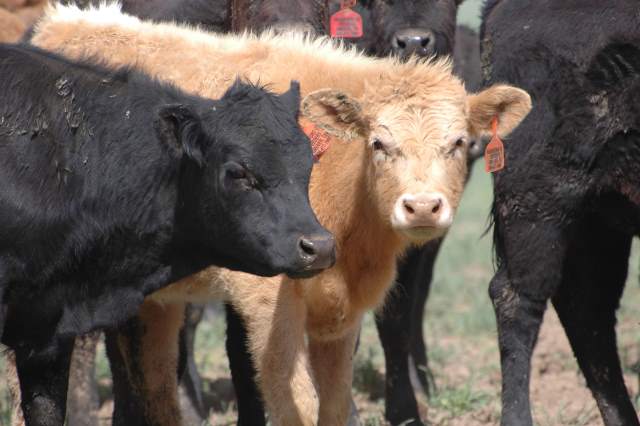December 22, 2015

Whether or not this week ends up marking the turning point to the seemingly endless price decline since summer, there’s no questioning recent signs of life. Cattle futures were mostly limit up last Friday and then again on Monday with expanded limits. The few early-week auctions dropped the gavel on calves and feeders at significantly higher prices, too. At Joplin Regional Stockyards in Missouri on Monday, for instance, 5-weight steer and heifer calves sold mostly $15-$20 per cwt higher. They traded $10-$15 higher at heavier weights.
“Last Friday’s strong limit-up futures trading for Live Cattle and Feeder Cattle is encouraging that perhaps a bottom is in place,” says Derrell Peel, Extension livestock marketing specialist at Oklahoma State University. “The holiday period is a difficult time to establish a new market trend and is it quite impossible to predict or even interpret market actions during holiday-disrupted trading. Nevertheless, an array of good market news the past few days revives Christmas hope for cattle markets.”
Peel points to the bullish monthly Cattle on Feed report Friday that indicates November placements were 11% less than the prior year—the fifth consecutive month of year-over-year declines.

70+ photos showcasing all types of cattle nutrition
Readers share their favorite photos of cattle grazing or steers bellied up to the feedbunk. See reader favorite nutrition photos here.
While still heavier year over year, Peel also points out carcass weights are finally lighter week to week.
“The most recent week of slaughter data (week ending December 5) shows that steer carcass weights dropped 10 pounds from the previous week to 913 pounds. This is still 12 pounds heavier than the same week one year ago,” Peel says. “Heifer carcass weights dropped 8 pounds to 846 pounds, still 22 pounds over last year at this time.”
Moreover, some uncertainty has left the market. The Fed finally raised interest rates. And, finally, mandatory country-of-origin labeling is officially dead. The omnibus spending bill passed by the Senate and signed by the president last week repeals that odious law.
Even if the bottom is in, plenty of the current challenges remain. Things like growing red meat and poultry supplies; export trade hamstrung by the value of the U.S. dollar and market barriers; and the ongoing incentive to decrease fed cattle losses by adding more weight with relatively inexpensive feed.
“Cattle prices are forecast to decline almost 8% compared with 2015, due to larger supplies of heavy cattle, high cold-storage stock levels, and sluggish foreign demand,” says analysts with USDA’s Economic Research Service in the December Livestock, Dairy and Poultry Outlook.
It’s worth keeping in mind that those projected prices are still some of the highest in history.
For perspective, analysts with the Livestock Marketing Information Center (LMIC), in the most recent Livestock Monitor, project average returns over estimated cash costs (basis the Southern Plains) next year at around $200 per cow. That’s a far cry from the past couple of years. From a historical perspective, though, it would be one of the few times that benchmark has ever been $100 or more.
LMIC uses an average steer and heifer calf price for the Southern Plains for the months of August through November and calendar-year average cull animal prices. Economic costs not considered in the calculations include: management and labor provided by the operator along with many capital asset costs involved with animals and equipment.
“It continues to look risky to use futures and options to hedge cattle at this point, but cash prices are yelling the word ‘Buy’ right now,” says Andrew P. Griffith, agricultural economist at the University of Tennessee, in his most recent weekly market comments “It is difficult to price a profit using futures on those cattle being purchased, but if seasonal trends and fundamentals related to limited feeder cattle supply kick in, then a profit should be achievable in 150 days.”
Griffith says it is very difficult and extremely risky to even begin trying to forecast where prices will be in a few weeks, much less three or four months from now. “The direction prices are headed may be a more achievable task and the outlook remains positive. There has not been any information that would suggest these prices should decline much more. However, there is a seasonal supply and demand pattern that would suggest prices will increase after the first of the year.”
At the very least, with many cash feeder auctions closed the next couple of weeks, along with limited futures trade, Peel says, “The holiday hiatus may provide a much-needed opportunity for cattle markets to break the emotional rollercoaster of market volatility that has wrung out the market this fall.”
You might also like:
7 ranching operations who lead in stewardship, sustainability
Photo Gallery: Laugh with Rubes cow cartoons
Beta agonists wrongly blamed for fatigued cattle syndrome
Did USDA open the door to animal rights groups?
60 stunning photos that showcase ranch work ethics
2016 weather outlook: Is drought in the forecast?
You May Also Like



